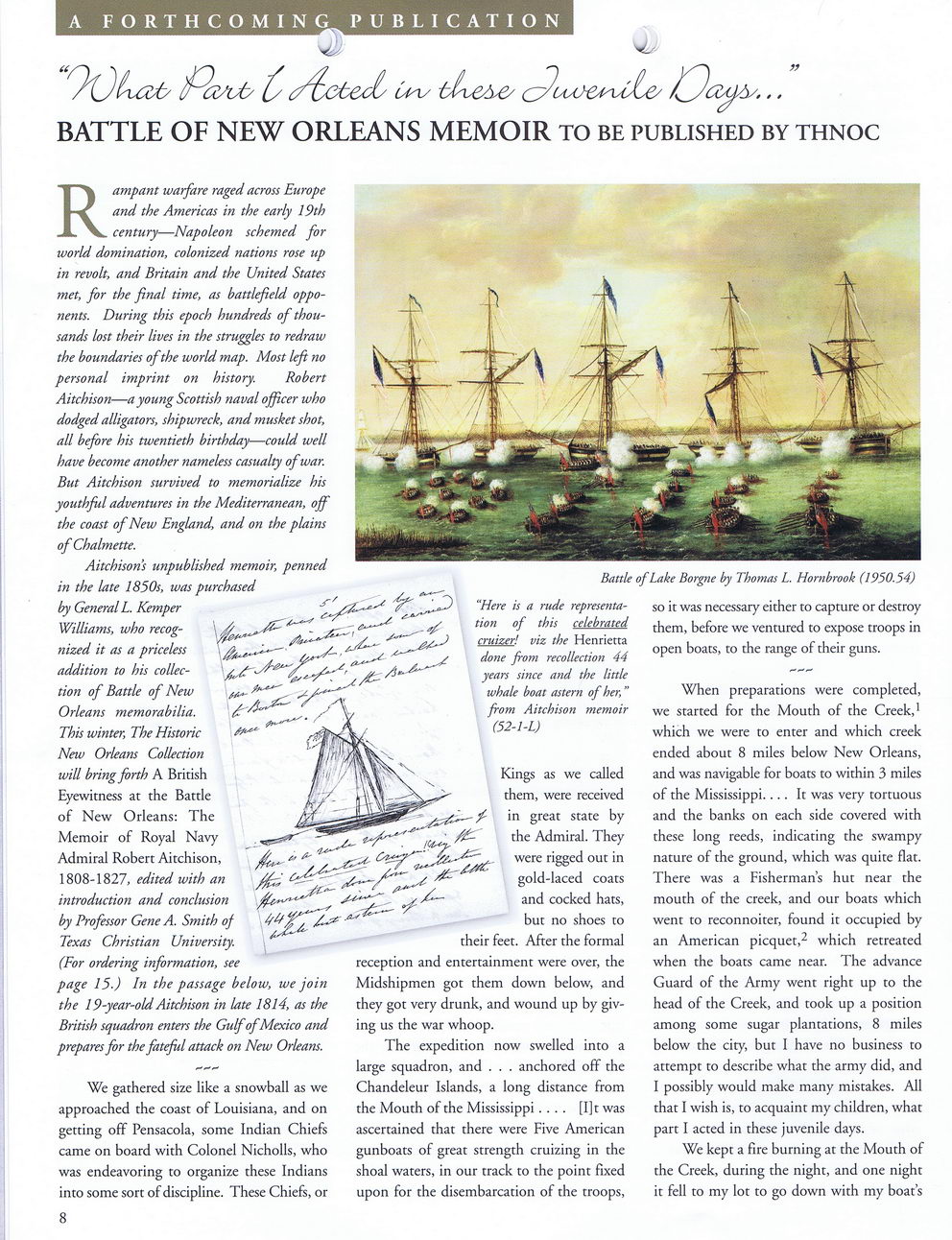This text was obtained via automated optical character recognition.
It has not been edited and may therefore contain several errors.
vU BATTLE OF NEW ORLEANS MEMOIR to be published by thnoc Rampant warfare raged across Europe and the Americas in the early 19th century?Napoleon schemed for world domination, colonized nations rose up in revolt, and Britain and the United States met, for the final time, as battlefield opponents. During this epoch hundreds of thousands lost their lives in the struggles to redraw the boundaries of the world map. Most left no personal imprint on history. Robert Aitchison?a young Scottish naval officer who dodged alligators, shipwreck, and musket shot, all before his twentieth birthday?could well have become another nameless casualty of war. But Aitchison survived to memorialize his youthful adventures in the Mediterranean, off the coast of New England, and on the plains of Chalmette. Aitchison?s unpublished memoir, penned in the late 1850s, was purchased by General L. Kemper Williams, who recognized it as a priceless addition to his collection of Battle of New Orleans memorabilia. This winter, The Historic New Orleans Collection will bring forth A British Eyewitness at the Battle of New Orleans: The Memoir of Royal Navy Admiral Robert Aitchison, 1808-1827, edited with an introduction and conclusion by Professor Gene A. Smith of Texas Christian University. (For ordering information, see page 15.) In the passage below, we join the 19-year-oId Aitchison in late 1814, as the British squadron enters the Gulf of Mexico and prepares for the fateful attack on New Orleans. We gathered size like a snowball as we approached the coast of Louisiana, and on getting off Pensacola, some Indian Chiefs came on board with Colonel Nicholls, who was endeavoring to organize these Indians into some sort of discipline. These Chiefs, or - Battle ?Here is a rude representation of this celebrated cruiser! viz the Henrietta done from recollection 44 years since and the little whale boat astern of her,? from Aitchison memoir (52-1-L) Kings as we called them, were received in great state by the Admiral. They were rigged out in gold-laced coats and cocked hats, but no shoes to their feet. After the formal reception and entertainment were over, the Midshipmen got them down below, and they got very drunk, and wound up by giving us the war whoop. The expedition now swelled into a large squadron, and . . . anchored off the Chandeleur Islands, a long distance from the Mouth of the Mississippi .... [I]t was ascertained that there were Five American gunboats of great strength cruizing in the shoal waters, in our track to the point fixed upon for the disembarcation of the troops, of Lake Borgne by Thomas L. Hornbrook (1950.54) so it was necessary either to capture or destroy them, before we ventured to expose troops in open boats, to the range of their guns. When preparations were completed, we started for the Mouth of the Creek,1 which we were to enter and which creek ended about 8 miles below New Orleans, and was navigable for boats to within 3 miles of the Mississippi.... It was very tortuous and the banks on each side covered with these long reeds, indicating the swampy nature of the ground, which was quite flat. There was a Fisherman?s hut near the mouth of the creek, and our boats which went to reconnoiter, found it occupied by an American picquet,2 which retreated when the boats came near. The advance Guard of the Army went right up to the head of the Creek, and took up a position among some sugar plantations, 8 miles below the city, but I have no business to attempt to describe what the army did, and I possibly would make many mistakes. All that I wish is, to acquaint my children, what part I acted in these juvenile days. We kept a fire burning at the Mouth of the Creek, during the night, and one night it fell to my lot to go down with my boat?s

Battle of 1814 Battle-of-New-Orleans-Memoir